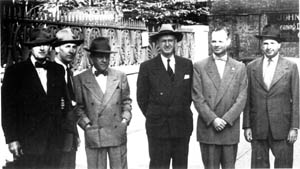Independence National Historical Park Advisory Commission
An early visitor to the fledgling park project was Horace M. Albright (center, in dark suit), former director of the National Park Service. With him are (from left) Francis Ronalds, Superintendent at Morristown National Historical Park; Melford O. Anderson, then assistant project manager; Joseph M. O'Brien, project manager; Dr. Edward M. Riley, historian; and Charles E. Peterson, resident architect. Behind the group, to the left, is the railing at the rear of the Second Bank of the United States. To the right is John's Tailor Shop, one of the disputed early buildings that was demolished to make way for the park.
The new staff, with the exception of Peterson, attended the first meeting of the Independence National Historical Park Advisory Commission on November 29, 1949. In many ways it resembled the meetings of the Shrines Commission. judge Lewis presided as chairman, and a number of the members were carryovers. Several of the guests had met frequently with the Shrines Commission: the architects Roy Larson and Grant Simon, the city planner Edmund Bacon, and Dr. William Lingelbach. The group gathered not at the project offices, but at the Rittenhouse Club, Lewis's turf. It was a sizable gathering of over forty people. Nine members of the commission attended. Undersecretary Chapman headed a delegation from Washington that included National Park Service Director Drury; Conrad Wirth, then assistant director; Thomas C. Vint, chief of planning; Ronald Lee, the chief historian; and Herbert Kahler, assistant chief historian. Thomas J. Allen, the agency's regional director, was also present, as was Francis J. Ronalds, who, as superintendent of Morristown National Historical Park in New Jersey, had been assigned oversight responsibilities for the new project. There was also a group from the city, led by City Solicitor Frank F. Truscott. Despite the presence of so much high-powered talent, most of the meeting was taken up with a review of the arrangements necessary before the park could be established.
It was only as the meeting drew to a close that a new and important subject was broached. Larson, speaking as the chairman of the city's Art jury, proposed that the City Planning Commission undertake a study of the areas surrounding the park. He wished to see these "fringes" rezoned to ensure that they would be architecturally compatible with the park's development. It was an idea that immediately appealed to Lee, who not only was one of the strongest proponents of the National Park Service's historic preservation activities, but had recently played a key role in the foundation of a new organization, the National Trust for Historic Preservation. Lee was in close communication with preservation groups around the country. He recommended that Philadelphia study the pioneering preservation ordinances of Charleston, South Carolina, and New Orleans. It would, however, be a number of years before the city took action to preserve areas adjacent to the park.
The meetings of the Advisory Commission were set at six-month intervals. In theory it seemed unlikely that a group that met so infrequently could exercise much power over decision making at Independence. In practice Lewis utilized his position as chairman to wield tremendous influence over the park's development. From the beginning the project staff conferred with Lewis about all significant planning activities on a regular and frequent basis. The project's top priority for its first year was to begin fulfilling the legislative mandate for land acquisition and consummation of cooperative agreements. By the summer of 1950, agreements had been signed with the City of Philadelphia, the Carpenters' Company, and the vestry of Christ Church. Early in 1950 the park project contracted with the Land Title Bank and Trust Company and the Commonwealth Title Company of Philadelphia for title searches on 123 separate properties. By the end of the year, options had been taken on fifteen properties. Two properties --one part of the street leading into Franklin Court from Chestnut Street and the other near Carpenters' Hall-had been offered for donation. The former was being given by the city, the latter by the Fairmount Park Art Association.




